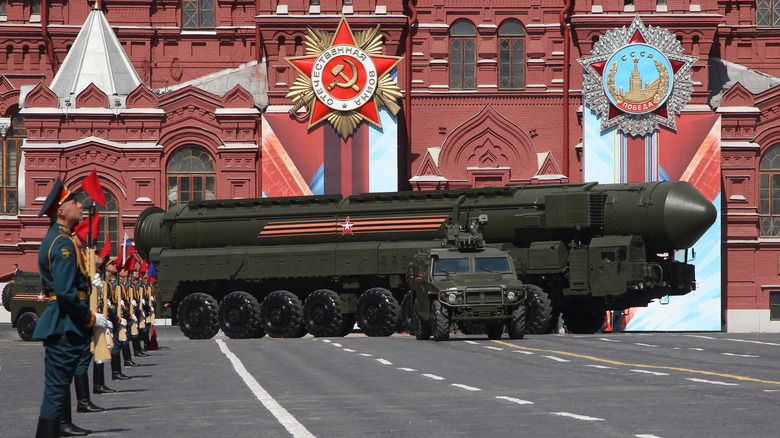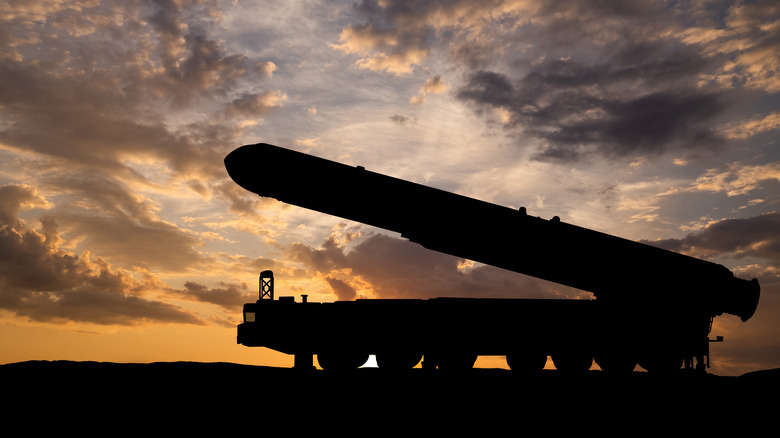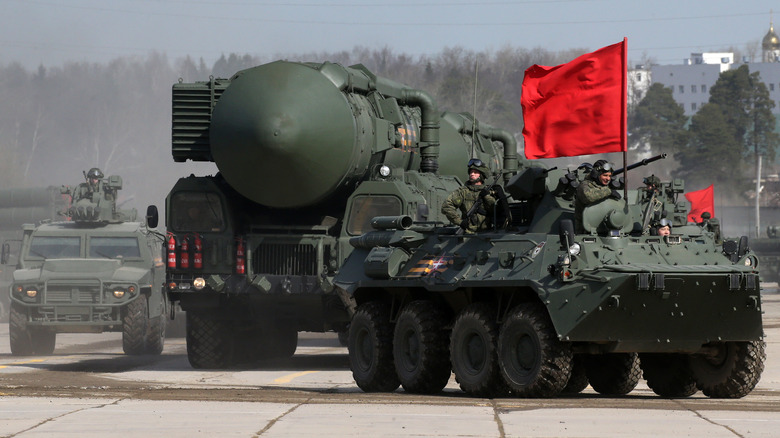ICBM: What It Means And Why It Matters
It's been nearly 80 years since the U.S. dropped two nuclear bombs on the Japanese cities of Hiroshima and Nagasaki. The massive loss of life and destruction caused by these atomic bombs led to Japan's surrender in World War 2. As the only instances of nuclear weapons being used against a civilian population, these bombings — to this day — serve as stark reminders about the sheer power these weapons of mass destruction possess. Since the 1945 nuclear bombings, nuclear weapons have only gotten more powerful and destructive. What has also become more advanced are the ways in which militaries deliver this atomic force.
Contrary to 1945, when the United States used B-29 bomber aircraft to drop these weapons over Japan, today, powerful militaries across the world have a far more efficient means to deploy missiles to virtually any point on the globe. Known as Intercontinental Ballistic Missiles or ICBMs, these are among the most advanced and feared weapon delivery systems in existence today. Several countries on the planet are known to possess ICBMs, including the United States, Russia, China, India, the United Kingdom, and France. Each of these countries also possesses nuclear warheads.
What are ICBMs?
As explained earlier, the term ICBM is short for Intercontinental Ballistic Missile, which is itself a subset of a category of missiles called ballistic missiles. There are several types of ballistic missiles in existence today. These include SRBMs (Short Range Ballistic Missiles) that typically can travel between distances of 43 and 620 miles, MRBMs (Medium Range Ballistic Missiles), which can have a range between 620 to 1,860 miles, and IRBMs (Intermediate Range Ballistic Missiles) that can travel distances between 1,860 to 3,410 miles.
Any ballistic missile capable of reaching targets beyond a distance of 3,410 miles falls into the category of ICBMs, according to the U.S. Congressional Research Service. If not already evident, the naming scheme of ICBMs indicates that the missile is capable of hitting targets located extremely far away, often capable of traversing continents before reaching their intended targets. The behavior and launch stages of ICBMs are very similar to rockets we send into space; consisting of multiple stages of flight. In fact, ICBMs spend more than 90% of their flight time outside of the atmosphere during intercontinental flights to their intended targets.
What makes ICBMs way more destructive than other delivery systems is a technology developed in the 1960s called MIRV (Multiple Independently-Targetable Reentry Vehicle). Unlike traditional missiles, which target a single location, with MIRV technology, a single ICBM can be programmed to target multiple locations, with the Russian MIRV missile currently under development able to carry 16 warheads.
A brief history of ICBMs in the U.S.
The U.S. started working on developing ICBMs right after the end of World War 2 when the government initiated Project MX-774. The Convair Astronautics Division of General Dynamics was awarded the contract to develop a ballistic missile, which was eventually named Hiroc by the Air Force, short for high-altitude rocket. Shortly after this project was announced, the U.S. government canceled the program in 1947. Convair did, however, use what was left of the government funding to complete three prototypes of the missile.
The main reason for the United States to go slow on the development of ICBMs was the security cover offered by its nuclear superiority over its rivals — especially the Soviet Union. However, after the U.S.S.R. also developed its first nuclear bomb in 1949, the U.S. also feared the possibility of a possible nuclear attack by a Soviet ICBM.
This threat perception eventually led to the U.S. developing ICBMs at an accelerated pace, starting with the development of the Atlas ICBM beginning in 1951. Three years later, the U.S. Air Force began work on the Titan 1 ICBM that featured several improvements over the Atlas. The Titan program was succeeded by the Minuteman series of ICBMs, work on which began in September 1959, the newest variants of which are still in use. Starting in 1965, the U.S. also started work on the Peacekeeper series of ICBMs, which remained in service between 1985 and 2005.
Why ICBMs matter today
Even though they have been around for well over 70 years and are widely considered to be the deadliest weapons delivery system to possibly ever exist, ICBMs have almost never been used during wars. Although some reports have pointed toward Russia recently launching an ICBM, the majority of reporting suggests that the missile was, in fact, an Intermediate Range Ballistic Missile (IRBM).
The destructive power packed by modern-day ICBMs is immense. This is precisely why these weapons — despite their sheer destructive nature — have been indirectly responsible for keeping the world safe from traditional wars spiraling into nuclear conflict. With all countries known to possess nuclear weapons and a stockpile of ICBMs capable of completely destroying each other in case of an escalation, these extremely deadly weapons have transformed themselves into effective deterrents against military escalations.
While there is no denying that the threat of an all-out nuclear war, leading to mutually assured destruction, is always a possibility, in some ways, it is this very threat that has prevented humankind from complete annihilation.



